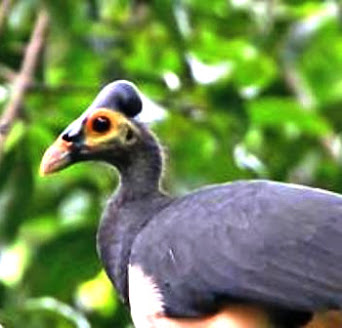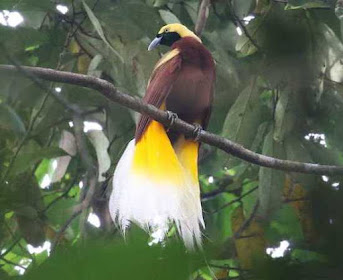In South Sulawesi, Indonesia, there is one endemic bird species that only exists on that island. This bird looks like a chicken, more often on the ground than in the trees. The people there call the bird the Maleo bird. The Latin name for this bird is Macrocephalon maleo S.
This bird has black fur, the skin around the eyes is yellow, the iris is brownish red, the legs are gray, the beak is orange and the underside feathers are whitish-red. On top of his head there is a hard black horn or crest. Males and females are similar. Usually the female is smaller and darker in color than the male bird.
 |
| Maleo Bird |
Monogamy
Even though they can fly like other birds, Maleo during the day prefers to be on the ground, they live in groups and prefer to run to hide when there is danger rather than fly away. At night they will sleep in the tree branches.
More than all that these birds are birds that are loyal to their partners, they live with one partner or monogamy. Behavior that is different from other types of poultry.
 |
| Monogamy Bird |
Reproduction
Maleo birds have a different way of reproduction when compared to other birds or poultry. Maleo birds do not incubate their own eggs, but bury them in the sand to get optimal heating so that they develop into bird embryos. This is done because it is physically difficult for the Maleo bird to incubate its eggs, because the eggs of this bird are relatively large compared to its body. The Maleo bird is about the size of a chicken, but the size of the egg is about 5 times larger than a chicken egg. The mother bird Maleo has to make extra effort, because every time she lays an egg she faints. They lay between 5 to 8 eggs and are buried in the sand as deep as approximately 50cm.
The bird's eggs will then hatch after 80 days of incubation. The tiny chicks didn't come out of the shell easily, considering they were buried at a depth of 50cm. Of course many of them died in the process. Because the process out of the nest takes up to 48 hours. The specialty of maleo chicks is that as soon as they hatch, they can fly right away, without waiting like other birds.
 |
| Maleo egg compared to Chiken egg |
Habitats
This bird feed consists of various seeds, fruit, ants, beetles and various other small animals. Maleo nest in open sand areas, areas around the coast of volcanoes and areas that are warm from geothermal heat to hatch their eggs.
After hatching, the Maleo cub digs its way out of the ground and hides in the forest. In contrast to chicks in general, whose wings are still in the form of fine hairs, the wing abilities of maleo chicks are like those of adult birds, so they can fly, this is because the nutrients contained in maleo eggs are five times that of ordinary eggs, maleo chicks must find their own food and avoid predators, such as snakes, lizards, cats, wild boars and eagles.
Even though this animal is endemic to Sulawesi, the maleo is not found throughout Sulawesi. This endemic bird population is only found in the lowland tropical forests of the island of Sulawesi, such as in Gorontalo (Bone Bolango and Pohuwato) and Central Sulawesi (Sigi and Bnggai).
 |
| Maleo on Habitat |
Rare and Endangered
This bird endemic to the island of Sulawesi is a type of animal whose status is endangered. Its existence in the wild is now difficult to find. This is caused by habitat destruction, poaching and the characteristics of the maleo in breeding.
Maleo chicks that hatch but fail to get out of the mound will die. Apart from that, baby birds also run the risk of being stolen and of being preyed upon by predators such as snakes and monitor lizards.
The good news is that currently the Government of Indonesia has made efforts to preserve the maleo population, one of which is in the Hungayono Gorontalo, Tambun and Muarapusian wildlife reserves. We hope that this noble endeavor will succeed and that it is possible for our children and grandchildren to meet face to face with this unique and rare bird.






Comments
Post a Comment